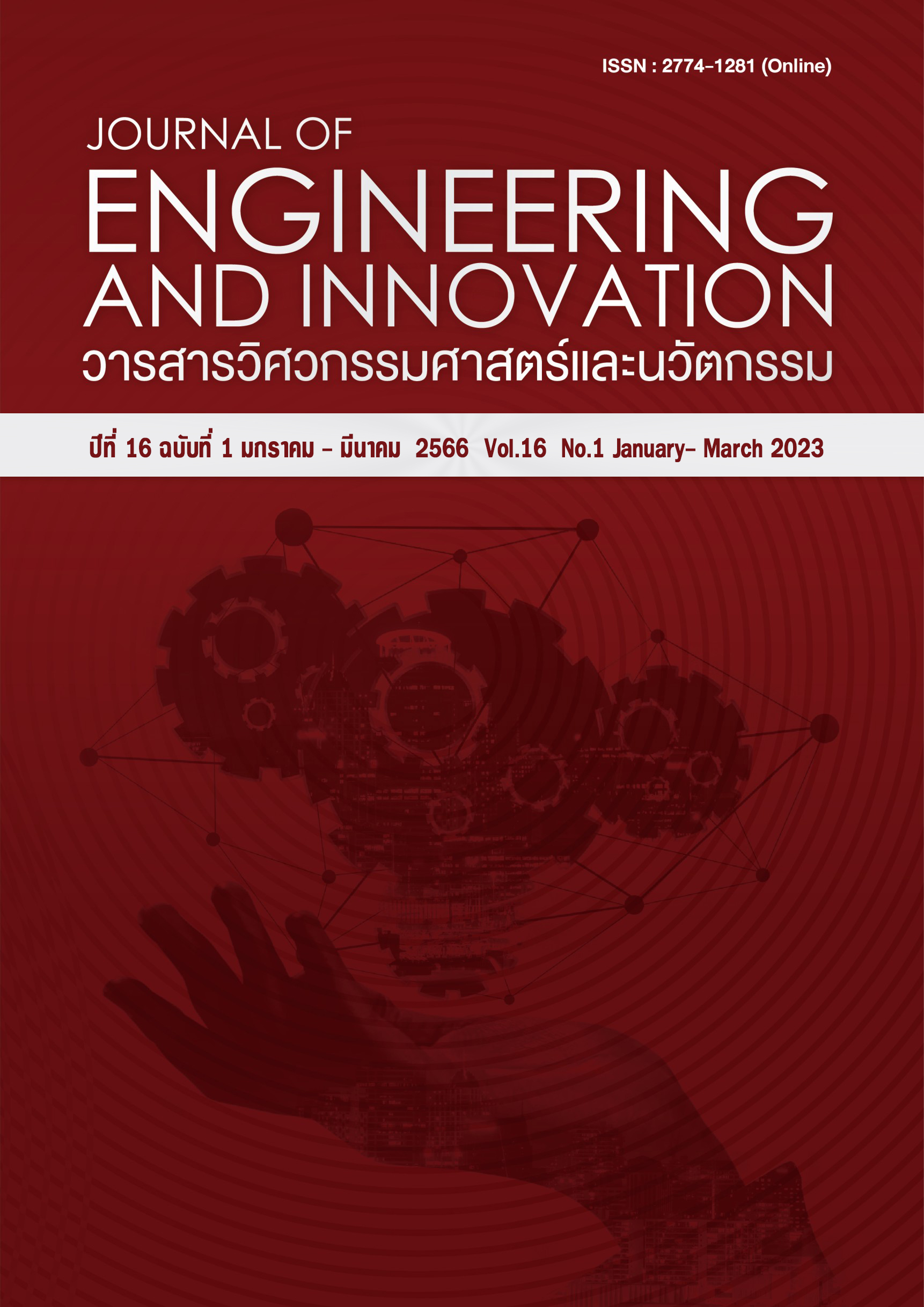Development of mechanical and physical properties of charcoal briquettes from rubber seeds mixed with coconut shells as alternative energy
Main Article Content
Abstract
This research aims to develop the mechanical and physical properties of charcoal briquettes from rubber seeds mixed with coconut shells. The replacement levels of rubber seeds charcoal powder with coconut shells charcoal powder of 0, 25, 50, 75, and 100 % by weight of rubber seeds charcoal powder were used in this study. The ratio of rubber seeds charcoal powder to tapioca flour of 10:1 was also used. The specimens at the age of 7 days were tested for compressive strength, bulk density, moisture content, calorific value, duration of burning until extinguishing, produce sparks and smoke. The test results showed that the increasing of coconut shells charcoal powder resulted in the increasing of compressive strength, bulk density, calorific value, and duration of burning until extinguishing while decreasing of moisture content values. All of these specimens do not produce sparks, do not smoke, and passed the standard requirement as per Thai Industrial Standard 238/2547 for charcoal briquettes and thus can be used as commercial charcoal briquettes. Which is considered as alternative environmental friendly energy.
Article Details
References
กรมพัฒนาพลังงานทดแทนและอนุรักษ์พลังงาน. รายงานดุลยภาพพลังงานของประเทศไทย 2562. กรุงเทพฯ: ศูนย์เทคโนโลยีสารสนเทศและการสื่อสาร; 2563.
กรมพัฒนาพลังงานทดแทนและอนุรักษ์พลังงาน. รายงานพลังงานทดแทนของประเทศไทย 2562. กรุงเทพฯ: ศูนย์เทคโนโลยีสารสนเทศและการสื่อสาร; 2563.
กรมพัฒนาพลังงานทดแทนและอนุรักษ์พลังงาน. คู่มือการพัฒนาและการลงทุนผลิตพลังงานจากชีวมวล. กรุงเทพฯ: บริษัท เอเบิล คอนซัลแตนท์ จำกัด; 2554.
Chumsang C, Upan P. Production of charcoal briquettes from palmyra palm waste in kirimat district, sukhothai province, thailand. Applied Environmental Research. 2017; 36(3): 29-38.
คฑาพล ปิ่นพัฒนพงศ์, ปิติพร มโนคุ้น, ภัทรมาศ เทียมเงิน, ฐนียา รังษีสุริยะชัย. การศึกษาคุณสมบัติของเชื้อเพลิงอัดแท่งจากเปลือกมะพร้าวและกากไขมันเหลือทิ้งจากมะพร้าว. วิศวกรรมสารฉบับวิจัยและพัฒนา. 2563; 31(4): 77-86.
Pongthornpruek S. The utilization of cashew shell residues and grease waste for charcoal briquette production. Applied Environmental Research. 2017; 39(1): 33-40.
Bonsu B.O., Takase M., Mantey J. Preparation of charcoal briquette from palm kernel shells: case study in Ghana. Heliyon. 2020; 6(10): 1-8..
Onchieku J.M., Chikamai B.M., Rao M.S. Optimum Parameters for the Formulation of Charcoal Briquettes Using Bagasse and Clay as Binder. European Journal of Sustainable Development. 2012; 1(3): 477-492.
Jamradloedluk J., Wiriyaumpaiwong S. Production and Characterization of Rice Husk Based Charcoal Briquettes. KKU Engineering Journal. 2007; 34(4): 391-398.
Zubairu A., Gana S.A. Production and Characterization of Briquette Charcoal by Carbonization of Agro-Waste. Energy and Power. 2014; 4(2): 41-47.
Wu S., Zhang S., Wang g., Mu C., Huang H. High-strength charcoal briquette preparation from hydrothermal pretreated biomass wastes. Fuel Processing Technology. 2018; 171: 293-300.
สำนักงานเศรษฐกิจการเกษตร. ข้อมูลการผลิตสินค้าเกษตร. เข้าถึงได้จาก: https://www.oae.go.th [เข้าถึงเมื่อ 2 พฤษภาคม 2564]
Laloon K, Sudajan S, Jansiri C. Studies on charcoal block production from three charcoal types of biomass employing screw press unit. Advanced Materials Research. 2013; 690-693: 1265-1274.
Hwangdee P, Jansiri C, Sudajan S, Laloon K. Physical characteristics and energy content of biomass charcoal powder. International Journal of Renewable Energy Research. 2021; 11(1): 158-169.
Kongprasert N, Wangphanich P, Jutilarptavorn A. Charcoal briquettes from madan wood waste as an alternative energy in thailand. Procedia Manufacturing. 2019; 30: 128-135.
สุภาษิต ชูกลิ่น. การผลิตไบโอดีเซลจากน้ำมันเมล็ดยางพารา. วิทยานิพนธ์วิศวกรรมศาสตรมหาบัณฑิต. มหาวิทยาลัยสงขลานครินทร์. 2547.
ธนกร หอมจำปา, อำไพศักดิ์ ทีบุญมา, ประพันธ์พงษ์ สมศิลา. เชื้อเพลิงอัดแท่งจากเปลือกเมล็ดยางพารา. ใน: การประชุมวิชาการระดับชาติ ราชมงคลสุรินทร์วิชาการ ครั้งที่ 8. มหาวิทยาลัยเทคโนโลยีราชมงคลสุรินทร์: สุรินทร์; 2559. หน้า B190-B196.
สำนักงานมาตรฐานผลิตภัณฑ์อุตสาหกรรม. มาตรฐานผลิตภัณฑ์ชุมชนถ่านอัดแท่ง มผช.238/2547. กรุงเทพฯ: กระทรวงอุตสาหกรรม; 2547.
ธนิยา เกาศล, วัฒนา ศรีเกต, วิชยัรัตน์ แก้วเจือ. ถ่านอัดแท่งจากเถ้าหนักของโรงไฟฟ้าชีวมวลจากรากไม้ยางพารา. ใน: การประชุมวิชาการวิศวกรรมโยธาแห่งชาติ ครั้งที่ 24. โรงแรมเซ็นทาราและคอนเวนชันเซ็นเตอร์: อุดรธานี; 2562. หน้า 2770-2776.
American Society for Testing and Materials. Standard Test Method for Moisture in the Analysis Sample of Coal and Coke ASTM D3173. West Conshohocken: ASTM International; 2003.
American Society for Testing and Materials. Standard Test Method for Gross Calorific Value of Coal and Coke ASTM D5865. West Conshohocken: ASTM International; 2010.
พัชราภรณ์ สมดี, กนกอร นุ้ยเล็ก, อนิวรรต หาสุข, ชานนท์ บุนนท์, พิตินันท์ วสันตเสนานนท์. การตรวจคุณสมบัติของถ่านอัดแท่งไร้ควันเมื่อเติมตัวประสานจากขยะพลาสติกพอลิสไตรีนและพอลิโพรพิลีน. วารสารวิจัย. 2559; 9(1): 61-67.
ลดาวัลย์ วัฒนะจีระ, ณรงค์ศักดิ์ ลาปัน, วิภาวดี ชัชวาลย์, อานันท์ ธัญญเจริญ, ภาคภูมิ รักร่วม. การพัฒนาก้อนเชื้อเพลิงชีวมวลจากเศษฟางข้าวผสมเศษลำไยเหลือทิ้ง. วารสารวิจัยและพัฒนา มจธ. 2559; 39(2): 239-255.
เอกลักษณ์ กิติภัทร์ถาวร, ประเสริฐ เรียบร้อยเจริญ, วลัยรัตน์ อุตตมะปรากรม. เชื้อเพลิงอัดแท่งจากการผลิตร่วมของตะกอนเปียกอุตสาหกรรมผลิตเอทานอล. วารสารวิจัยพลังงาน. 2556; 10(3): 43-56.
ศตพล มุ่งค้ำกลาง. การหาประสิทธิภาพของแท่งเชื้อเพลิงจากถ่านกะลามะพร้าวและวัสดุเหลือใช้ทางการเกษตรในการประกอบอาหาร. วารสารวิชาการคณะเทคโนโลยีอุตสาหกรรม : เทพสตรี I-TECH. 2559; 11(1): 59-67.
สุกัญญา ทับทิม, ศศิธร ปรือทอง. การเปรียบเทียบค่าความร้อนของก้อนเชื้อเพลิงจากส่วนผสมของถ่านกะลามะพร้าวและก้อนเห็ดหลังการเก็บผลผลิต. วารสารมหาวิทยาลัยศรีนครินทรวิโรฒ (สาขาวิทยาศาสตร์และเทคโนโลยี). 2563; 12(24): 158-168.
อำนวย คำบุญ, วรพจน์ ศิริรักษ์, พีรวัตร ลือสัก, เริงฤทัย ศิริรักษ์. การศึกษาผลของวัสดุผสมในถ่านอัดแท่งกะลามะพร้าวต่อสมบัติทางกลและทางความร้อน. วารสารข่ายงานวิศวกรรมอุตสาหการไทย. 2562; 5(2): 67-75.
รุ่งโรจน์ พุทธีสกุล, อุปวิทย์ สุวคันธกุลม, อัมพร กุญชรรัตน์. การผลิตถ่านอัดแท่งจากถ่านกะลามะพร้าวและถ่านเหง้ามันสำปะหลัง. วารสารวิชาการอุตสาหกรรมศึกษา. 2553; 4(2): 18-28.

